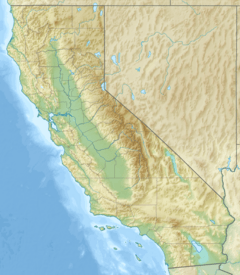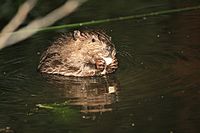Alhambra Creek facts for kids
Quick facts for kids Alhambra Creek |
|
|---|---|

Beaver yearling on Alhambra Creek in downtown Martinez.
|
|
|
Location of the mouth in California
|
|
| Other name(s) | Arroyo del Hambre |
| Country | United States |
| State | California |
| Region | Contra Costa County |
| City | Martinez |
| Physical characteristics | |
| Main source | Briones Hills 4 mi (6 km) west of Pleasant Hill, California 1,034 ft (315 m) 37°56′22″N 122°7′43″W / 37.93944°N 122.12861°W |
| River mouth | Arroyo del Hambre Martinez, California 203 ft (62 m) 37°58′24″N 122°7′34″W / 37.97333°N 122.12611°W |
| Basin features | |
| Tributaries |
|
Alhambra Creek is a stream in Contra Costa County, California. It flows through the East Bay area of the San Francisco Bay Area.
Contents
Exploring Alhambra Creek
Alhambra Creek flows into the Carquinez Strait at Martinez. The creek and its valley were once called "Cañada del Hambre." This Spanish name means "valley of hunger." It might have come from a story about hungry Spanish soldiers.
The lower part of the creek was officially named "Arroyo del Hambre." But John Muir's mother-in-law, Mrs. John Strentzel, didn't like that name. She decided to call the lower creek "Alhambra Creek" too. Today, most people call the whole creek "Alhambra Creek." Two smaller streams, Arroyo del Hambre Creek and Franklin Creek, flow into it.
Where the Creek Flows
The Alhambra Creek area covers about 16.5 square miles (43 km2). It includes parts of Martinez. The creek flows through open spaces, wildlife areas, and residential neighborhoods. It goes through downtown Martinez and then into the Carquinez Straits. It ends in a wetland at the Martinez Regional Shoreline.
The Creek's Journey
Alhambra Creek starts in the Briones Hills, inside Briones Regional Park. The water comes from a tunnel in the side of a hill. This tunnel was dug long ago. People thought a huge underground river from the Sierra Nevada mountains was there. But they were wrong, so the tunnel was left alone.
The creek flows for about 6 miles (10 km) from its start to where it meets the Carquinez Strait. In its first 2 miles (3 km), it drops from about 1,100 feet (300 m) to 200 feet (60 m) high. Then, Arroyo del Hambre Creek joins it. This creek starts about 900 feet (300 m) high and flows for 3 miles (5 km).
Franklin Creek joins Alhambra Creek about 2 miles (3 km) downstream. Franklin Creek flows through John Muir National Historic Site. There are no big dams or factories along the creek.
Amazing Beavers of Alhambra Creek





In 2006, something exciting happened! A male and female beaver moved into Alhambra Creek in downtown Martinez. These beavers built a dam 30 feet (9 m) wide and once 6 feet (2 m) high. They chewed on many trees planted by the city.
The city was worried about flooding. But local people wanted to protect the beavers. They formed a group called Worth a Dam. They found a solution: a special pipe was put through the beaver dam. This pipe helps control the water level, so it doesn't get too high.
Now, the beavers are protected. They have changed Alhambra Creek a lot! Their dams and ponds have brought back many animals. These include birds, steelhead trout, river otters (in 2008), and mink (in 2009). Beavers are a "keystone species." This means they are very important to their ecosystem. They help many other species thrive.
For example, in 2010, a green heron was seen catching a tule perch. This was the first time this type of fish was recorded in Alhambra Creek! Also, a pair of hooded merganser ducks arrived in December. The beaver parents have had babies every year since 2006. Sadly, in June 2010, "Mom Beaver" passed away naturally.
In 2009, the Martinez City Council approved a special mural. It has 81 tiles and is on the Escobar Street bridge. Schoolchildren created the mural. It was donated by Worth a Dam to celebrate the beavers and other wildlife in Alhambra Creek.
Beavers in History
The Martinez beavers likely came from the Sacramento–San Joaquin River Delta. Long ago, before the California Fur Rush, this Delta had many beavers. The fur trade was very important in opening up California to the world. Many countries hunted beavers and other animals for their fur.
Between 1826 and 1845, the Hudson's Bay Company sent groups to trap animals in the Sacramento and San Joaquin valleys. They caught many beavers. One report said they took 4,000 beaver skins from the San Francisco Bay area in one year! These skins were worth a lot of money.
In 1840, an explorer named Captain Thomas J. Farnham wrote about the beavers. He said there were "very numerous" beavers near the Sacramento and San Joaquin rivers. He thought there was no other place in America with so many of these animals.
The Land Around the Creek
The land around Alhambra Creek has been shaped by its geology. Millions of years ago, the area was deep ocean. Layers of sand and mud piled up and turned into rock. Later, these rocks folded and faulted, forming the hills we see today. Erosion then carved valleys and left harder rocks as hills.
Some rocks in the area have seashell fossils. This tells us they were once layers of sand in a shallow sea. The "Martinez formation" and "Hambre formation" are named after the town and the creek.
A big change to the land was made by people. The area north of Main Street was created by adding huge amounts of sediment. This sediment came from the Sacramento River. It was a result of hydraulic mining during the California Gold Rush. More runoff from Alhambra Creek also added to it. Old maps from 1850 show the shoreline was much further south.
Wildlife and Nature
The Alhambra Creek area has two main types of plant communities. About half is coastal oak woodlands. These are found on north and east-facing slopes. The other half is California annual grassland. This is found on drier ridges and west and south-facing slopes.
In the oak woodlands, you'll find trees like coast live oak, blue oak, and California bay laurel. Many other plants grow beneath these trees. These include native and introduced grasses, wildflowers, and small shrubs.
California's grasslands used to be full of native grasses. But over time, new grasses from Europe took over. Now, these introduced grasses are most common. The grasslands also have many wildflowers.
Animals of the Creek
- Deer use the woodlands for food, cover, and shade.
- Coyotes and mountain lions hunt deer.
- Many bird species use the trees for food and nests.
- Skunks and raccoons live in the woodlands, eating small animals and plants.
- Ground squirrels are important in the grasslands. They are food for coyotes, hawks, and eagles.
Along Alhambra Creek, you'll see trees like willows, cottonwoods, and sycamores. Shrubs like elderberry and California blackberry also grow here. The American beaver has recently returned to Alhambra Creek. As a keystone species, their ponds help many animals. These include steelhead trout, other fish, birds, otters, and mink.
Long ago, Alhambra Creek probably had salmon and steelhead fish. The Martinez Packing Company used to can and ship a lot of salmon. This was from the huge numbers of salmon in the Sacramento/San Joaquin River system.
At the mouth of Alhambra Creek, there's a coastal marsh. Salt grass and pickleweed grow here. The salt marsh harvest mouse, a protected species, lives in these areas. Many shore birds also nest in the marsh. They build their nests on the ground. This is why dogs are not allowed in the Martinez Regional Shoreline near the creek's mouth.
Bears in the Past
In the past, California grizzly bears and black bears lived here. People saw black bears in the upper creek area until the 1930s and 1940s. By the 1950s, people thought all the bears were gone. But in 1965, a bear was hit by a car and died on San Pablo Dam Road.
Protecting the Creek
In 1997, efforts to protect the creek began. The Alhambra Creek Watershed Council was formed. Their goal is to keep the Alhambra Creek Watershed healthy. They teach people about the watershed and help with new projects. Many groups work together to protect this important natural area.




